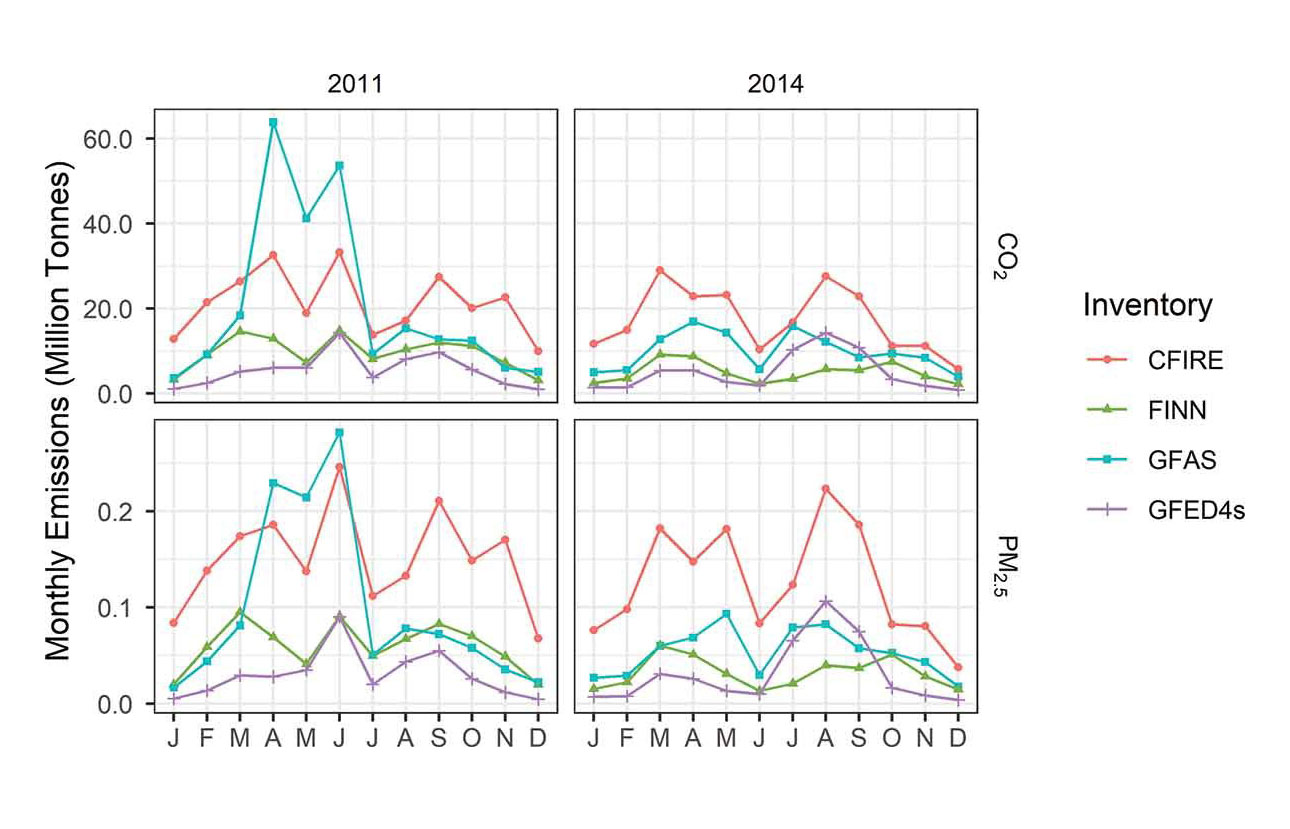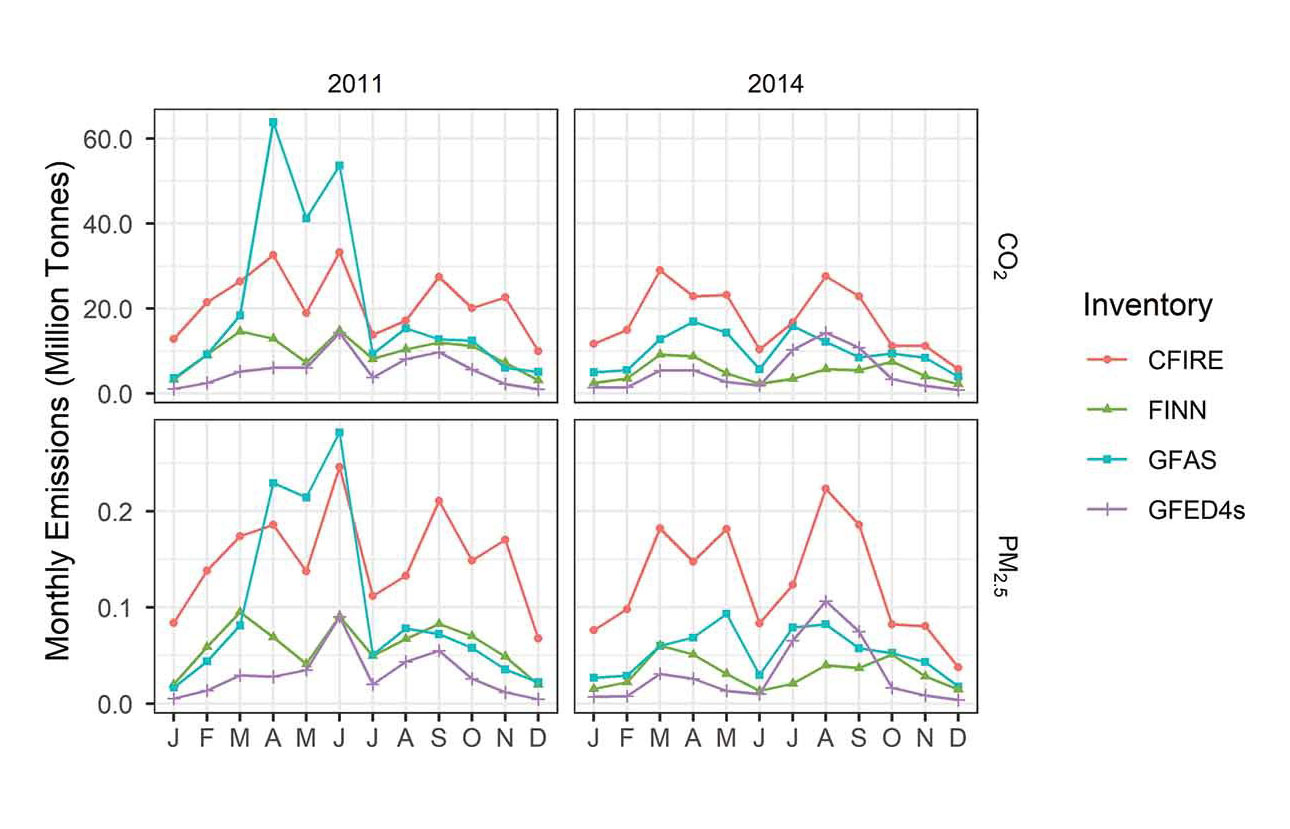Journal Article: CFIRE Inventory - Wildland Fire Emissions Developed for the 2011 and 2014 U.S. NEI
Clients
U.S. Environmental Protection Agency (EPA)
U.S. Forest Service (USFS) National Fire Plan
Joint Fire Science Program
Wildfires and wildfire smoke emissions are a growing concern across the United States. As part of the Comprehensive Fire Information Reconciled Emissions (CFIRE) effort, Sonoma Technology scientists used satellite data and other resources to help government agencies better understand air pollutant emissions from wildfires and prescribed burns. We used satellite fire detections and national, state, tribal, and local databases, to obtain an accurate, time-resolved inventory of fire-related emissions. Our work was completed for the EPA’s 2011 and 2014 National Emissions Inventories, or NEI, and reconciled a wide range of available fire information sources into a single coherent inventory. </p>
The results of this study were published in the <a href="https://www.tandfonline.com/doi/full/10.1080/10962247.2020.1802365" target="_blank">Journal of the Air & Waste Management Association.</a href></p>
The full abstract of the article is below.<br>
Wildland fire emissions from both wildfires and prescribed fires represent a major component of overall U.S. emissions. Obtaining an accurate, time-resolved inventory of these emissions is important for many purposes, including to account for emissions of greenhouse gases and short-lived climate forcers, as well as to model air quality for health, regulatory, and planning purposes. In collaboration with USFS and EPA, Sonoma Technology developed a new methodology for EPA’s 2011 and 2014 National Emissions Inventories to reconcile the wide range of available fire information sources into a single coherent inventory. The CFIRE inventory effort utilized satellite fire detections as well as a large number of national, state, tribal, and local databases. The methodology and results for CONUS and Alaska were documented and compared against other fire emissions databases, and the efficacy of the overall effort was evaluated. Results show the overall spatial pattern differences and relative seasonality of wildfires and prescribed fires across the country. Prescribed burn emissions occurred primarily in non-summer months, were concentrated in the Southeast, Northwest, and lower Midwest, and were relatively consistent year to year. Wildfire emissions were much more variable but occurred primarily in the summer and fall. Overall, CFIRE represents a third of total emitted PM<sub>2.5</sub> across all sources in the National Emissions Inventory, with prescribed fires accounting for nearly half of all CFIRE emissions. Compared with other wildland fire emissions inventories derived solely from satellite detections, the CFIRE inventory shows markedly increased emissions, reflecting the importance of the multiple national and regional databases included in CFIRE in capturing small fires and prescribed fires in particular.
The results of this study were published in the <a href="https://www.tandfonline.com/doi/full/10.1080/10962247.2020.1802365" target="_blank">Journal of the Air & Waste Management Association.</a href></p>
The full abstract of the article is below.<br>
Wildland fire emissions from both wildfires and prescribed fires represent a major component of overall U.S. emissions. Obtaining an accurate, time-resolved inventory of these emissions is important for many purposes, including to account for emissions of greenhouse gases and short-lived climate forcers, as well as to model air quality for health, regulatory, and planning purposes. In collaboration with USFS and EPA, Sonoma Technology developed a new methodology for EPA’s 2011 and 2014 National Emissions Inventories to reconcile the wide range of available fire information sources into a single coherent inventory. The CFIRE inventory effort utilized satellite fire detections as well as a large number of national, state, tribal, and local databases. The methodology and results for CONUS and Alaska were documented and compared against other fire emissions databases, and the efficacy of the overall effort was evaluated. Results show the overall spatial pattern differences and relative seasonality of wildfires and prescribed fires across the country. Prescribed burn emissions occurred primarily in non-summer months, were concentrated in the Southeast, Northwest, and lower Midwest, and were relatively consistent year to year. Wildfire emissions were much more variable but occurred primarily in the summer and fall. Overall, CFIRE represents a third of total emitted PM<sub>2.5</sub> across all sources in the National Emissions Inventory, with prescribed fires accounting for nearly half of all CFIRE emissions. Compared with other wildland fire emissions inventories derived solely from satellite detections, the CFIRE inventory shows markedly increased emissions, reflecting the importance of the multiple national and regional databases included in CFIRE in capturing small fires and prescribed fires in particular.
Air Quality
Emissions
Fire and Smoke
Measurements
Policy and Planning


Crystal D. McClure

Crystal
D.
McClure
Senior Atmospheric Data Scientist
cMcClure@sonomatech.com
/sites/default/files/2025-03/CDMres.pdf
